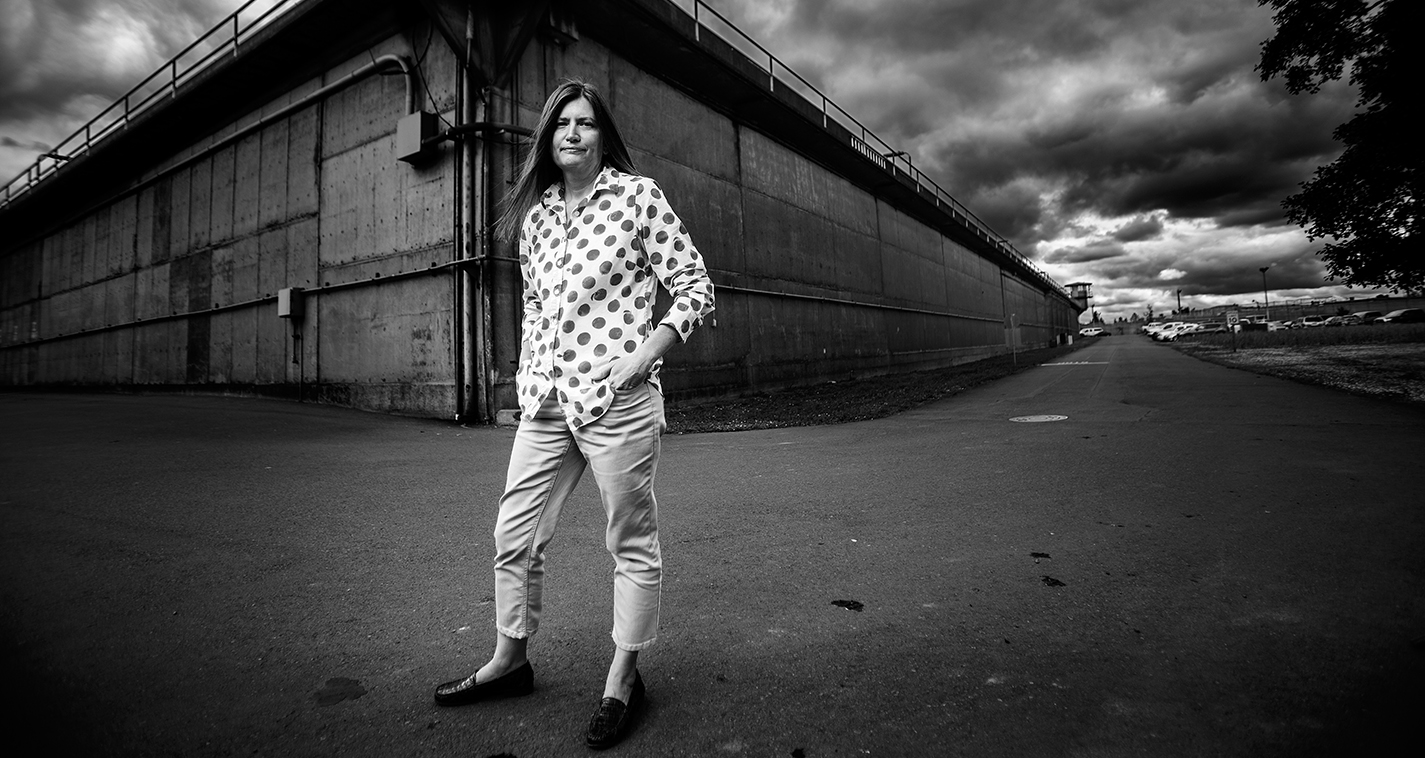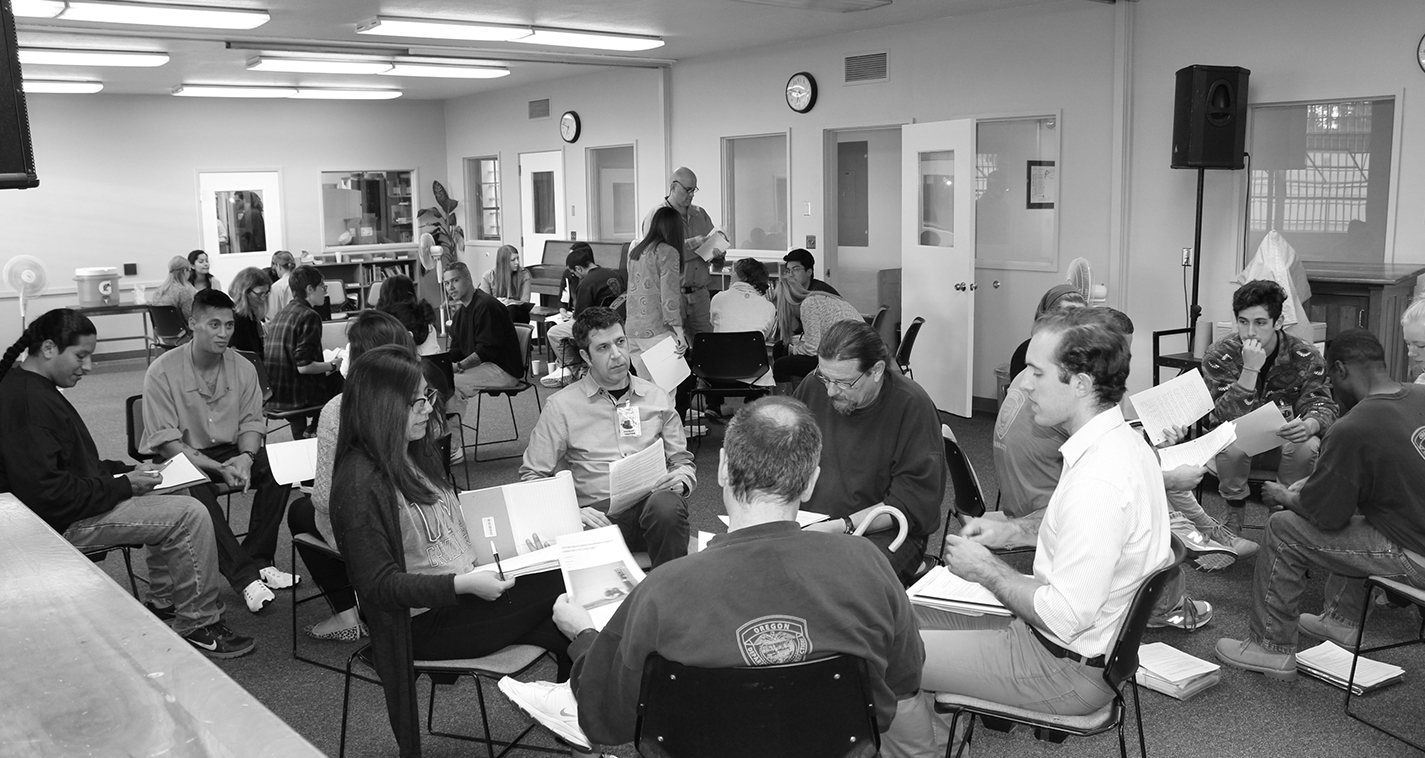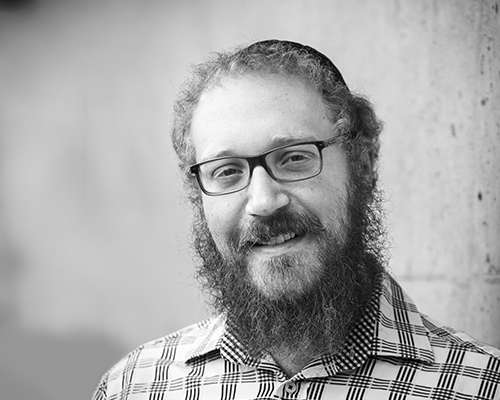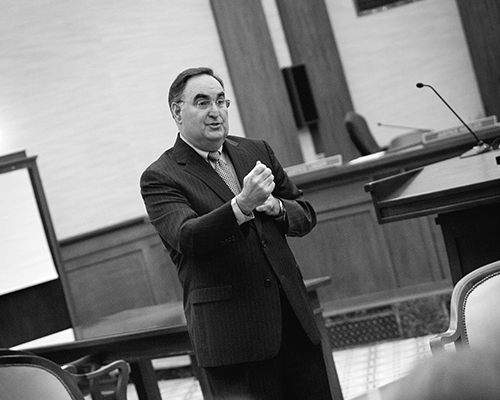The 34 students in Professor Melissa Buis Michaux’s “Reforming Criminal Justice” class settle their chairs into a big circle, waving across the room at classmates they didn’t get to speak to earlier and hastily finishing up conversations with neighbors. It’s a dismayingly hot day to be on the top floor of a five-story building in a room that faces the late-afternoon sun, a room with no air conditioning, only two shades for three large windows and a few white plastic fans that whir furiously but don’t cool. For a few minutes, everyone moans about the heat.
Then Michaux asks everyone to go around the circle and talk about what they’ve learned from the class, which started in January and is now in its final weeks.
Alex says, “I’ve learned that empathy and compassion is what will save our country.”
James says, “I’ve learned that good things happen in spaces that encourage community."
Sam says, “I’ve learned to be a more thoughtful listener.”
Ernest says, “I’ve learned I don’t have to give up hope that the system will change.”
Mandy says, “I’ve learned how variable prisons are among states and within states.”
Joey says, “My biggest takeaway is the amount of empathy we experience here every Monday night. Our conversations stay with me all week.”
Ben says, inciting peals of sympathetic laughter, “I’ve learned that I don’t want to read any more Foucault.”
While the class clearly enjoys a sense of camaraderie, two very different constellations of “us” exist in the room. Alex, Sam, Mandy, Joey and 13 others are upper-division students from Willamette University. James, Ernest, Ben and another 14 men are students from the Oregon State Penitentiary (OSP), a maximum-security prison where the class meets for nine of its 15 classes.
Although the university is located less than two miles away from the prison on the same street, the Willamette students’ journey is a huge and culturally challenging departure from their regular lives. They arrive at the visitors’ room desk, where their names are checked off a list submitted by the prison chaplain, Rabbi Avrohom Perlstein. They pass in groups through the metal detectors and an electronically unbolted door into another room, where they sign in and reach their hands through a dark slit in a smoked-glass wall to hand over their IDs to an unseen official and receive a prison badge. Another door slides open and they march through and line up along a hallway, then move to another smoked-glass wall where a shadowy figure on the other side asks for their name and badge number, as curious inmates stare from across the room. Then they climb the four flights of stairs to the classroom.
The inmates’ journeys are much longer, depending on where you begin counting the steps. Many arrived from childhoods of poverty and neglect and abuse, foster homes and juvenile detention, and they’ve been in prison for decades. Some were involved in horrific crimes, including murder. They look oddly collegiate, though: they are all required to wear blue — blue jeans, blue T-shirts, blue sweatshirts — and the blues are imprinted in orange with the prison’s crest. The crest makes their clothes look like college sportswear, except that the word “inmate” is also printed there in bold orange letters.
If some students were a little nervous about going into the prison, some of their parents panicked. Alex Tuchman ’16, a psychology major, wanted to take the class because she’s done some work assisting victims of crimes and — as she makes plans to attend law school in a couple of years — wanted to understand offenders and the larger workings of the criminal justice system. On the first day of class, she got a call from her father, asking her to reconsider. “This isn’t ‘Orange Is the New Black,’” he pleaded, referring to the popular Netflix program. “You don’t have to go.”
But Tuchman — who says taking the class was one of the most important decisions of her life and changed her trajectory — explains that her parents have come around to a more nuanced view of the inmates. “They understand that people can make mistakes,” she says, “and that their crimes don’t define them.”
Michaux hoped her Willamette students’ experience inside the prison would lead to that gray-shaded view of offenders. “It’s easy to engage in ‘othering’ when there isn’t a human face attached,” Michaux explains. “It’s easy to make judgments —‘That could never be me’ or ‘Anyone who would do that is beyond redemption’ — when you don’t have someone sitting in front of you. The OSP guys are very open about the wrongs they’ve committed and their backgrounds. When you interact with them, you see the possibility of redemption.”
Or as one inmates says, “When I was a kid, I had one of those View-Masters that you could look through and see things in stereo. Before all of you came here, you had just one image of us. Now you have another image. Maybe you see us in a new way.”
◊◊◊◊◊
According to the Prison Policy Initiative, the United States currently imprisons about 2.4 million men, women and children and is believed by many to have more people incarcerated than any other country in the world. Some 10 percent of these people serve life sentences. According to Columbia University law professor Robert Ferguson, our per capita imprisonment rate is seven times greater than that of Europe. American inmates also stay in prison longer, sentenced to longer terms than other countries — and much longer than four decades ago. By the Bureau of Justice Statistics tally, 80,000 people are in solitary confinement in our prisons at any given time. All this incarceration is expensive: prisons and jails cost some $80 billion a year, with strained state and local governments shouldering 90 percent of the bill.
Much of this rise in the prison population stemmed from the War on Drugs, launched by President Richard Nixon in 1971 and escalated in the 1980s by President Ronald Reagan. As discussed by civil rights lawyer and scholar Michelle Alexander in her book, “The New Jim Crow: Mass Incarceration in the Age of Colorblindness” — one of the readings for Michaux’s class — “Drug offenses alone account for two-thirds of the rise in the federal inmate population and more than half of the rise in state prisoners between 1985 and 2000 …. More than 31 million people have been arrested for drug offenses since the drug war began.”
Most of those arrested weren’t “kingpins” or predatory dealers, either. As Alexander points out, four out of five drug arrests in 2005 were for possession. Harsh changes in public policy regarding drugs and other crimes, along with discriminatory policing and prosecution, have been especially devastating for African-American communities around the country. According to the Equal Justice Initiative, black men are more than six times more likely to be incarcerated than white men. Given current trends, one of every three black men born in 2001 will go to jail or prison.
Undoubtedly, crime often ruins the lives of victims’ families, who may lose loved ones, financial security, their health or a sense of safety. But it also disrupts the families of the offenders, who may be deprived of breadwinners, parents and other people who are important parts of the family structure. Almost one in 40 children in America has an incarcerated parent, and the damage to these children can last a lifetime. According to research by the University of Virginia’s Prisoners and Their Families Project, children with an incarcerated parent are at higher risk for lower academic achievement, mental illness, family disruptions and crime.
And many of the people sentenced to prison are under 18 — children themselves. The Equal Justice Initiative notes that thousands of such children have been sentenced as adults and sent to adult prisons, and nearly 3,000 have been sentenced to life without parole. At any given time, around 10,000 children are housed in our adult jails and prisons.
These statistics are so staggering that most of us can’t take them in — or more likely, we never hear them in the first place because prisoners and their stories are typically walled away from the rest of society. But for Michaux’s students, the statistics have assumed an indelibly human form. Willamette students Alex Tuchman and Chantal Snedden were talking to two OSP students about sentences for juvenile offenders. One ran his fingers over the inside of his arm, where a grim tattoo rode above his watchband.
“I was 19 when I was sentenced to 21 years,” he said. “It felt like a death sentence. It felt like I died.”
The tattoo showed Death holding two swords, standing over a tombstone bearing the inmate’s name and the words “RIP: Long Live the King.” The inmate says he accepted a plea bargain for two counts of robbery in the first degree and one count of attempted robbery to avoid a potential 160-year sentence if his case went to trial. He is far from unique: Most prisoners are behind bars because they agreed to plead guilty in lieu of a trial.
“I was the king in my family,” he says of the motto on the tombstone. “I always made sure we got together and had family reunions, things like that. But when I went to prison, they ended up falling apart from each other.”
◊◊◊◊◊
Michaux began teaching at Willamette University 16 years ago. Her research has focused on welfare policy, and, among other things, she offers students a feminist perspective that looks at how welfare policies can function as a form of social control over poor women. Over the last few years, she started to think about social-control mechanisms over poor men and, through some of the work from scholars such as Michelle Alexander and Marie Gottschalk, realized that many of those poor men were in prison. She saw research showing that counties in Florida with the most punitive welfare policy also have the most punitive criminal justice policy. Intrigued by the connection, she devoted part of her 2014-15 sabbatical to researching mass incarceration.
Michaux found out that Perlstein ran a series of eight-week classes inside OSP focusing on restorative justice, an approach that shifts the emphasis from punishment to repairing the harm caused by criminal behavior. According to the Centre for Justice & Reconciliation, “Restorative justice recognizes that crime hurts everyone — victims, offenders and community. It creates an obligation to make things right.” This approach, adopted worldwide in various settings, addresses the needs of victims, offenders and communities, and aims to rebuild the connections that both crime and the criminal justice system have sundered.
Michaux figured that going to the class and getting a better understanding of offenders would help improve her teaching of the subject, and the rabbi welcomed her to the group. She was a little nervous about how the men would react, though.
“I thought I could be dismissed as a pointy-headed academic,” Michaux says. “Instead, they were grateful that I was there and cared a lot about what I thought. That surprised me, but I was even more surprised by how they were trying to figure out how to have lives of meaning given their circumstances. I thought that was profound. It’s something all of us are trying to do.”
Michaux attended six of the rabbi’s restorative justice classes, then brought freshmen students taking her fall 2015 class, “The Politics of Punishment,” to the prison for a tour and to engage with several prisoners. She saw that the students learned a lot from the exchange and that the prisoners appreciated it, too. While many classes from Oregon universities visit the prison, they generally focus on criminology, not the politics of incarceration or restorative justice.
With input from Perlstein and a group of prisoners, Michaux worked out the details for an upper-division class in which inmates who had been engaged in the restorative justice work and Willamette students would come together as peers, doing the same readings and papers and meshing in critical discussion. She knew her Willamette students would benefit from the class, but she wasn’t sure what the prisoners would get out of it.
As it turned out, they appreciated her students’ interest. “The prisoners told me they feel forgotten by society; about half of them have no visitors from the outside at all,” Michaux says. “And they wanted an intellectual environment where people took their views seriously. They told me not to lower my standards, that they wanted me to grade their papers and give feedback.”
The class focuses on a range of issues related to the causes and consequences of incarceration. Some of the readings prompt students to explore the various motivations behind imprisonment — to punish, to express umbrage, to deter future crime — and think about why it’s different here in the United States than in other countries. Some ask students to examine factors such as peer pressure that drive people to commit criminal acts, or to ponder what purpose prisons serve and whether they actually decrease crime. Other readings delve into the flaws in our criminal justice system: the racial disparities in policing and prosecution, the emphasis on punishment over rehabilitation, the damaging impact of incarceration on poor families and communities.
Thirty percent of the Willamette students’ grades are based on a research project, undertaken in small groups with inmates, which presents detailed solutions to a current problem in the criminal justice system. One group worked on a revision of visitation policies and procedures to make them more family-friendly; another developed a proposal for increased vocational opportunities for prisoners nearing release. One group chased after visionary reform with a proposal for an “open prison” like Norway’s Bastøy, located on an island and often called the nicest prison in the world — and thought to have the world’s lowest reoffending rate.
All the proposals are directed to a specific audience like the Department of Corrections, a nonprofit or a lawmaker. As the groups were in the final stages of researching and consolidating their ideas, Willamette alum Greg Alderson ’11, now the legislative director for Oregon House Speaker Tina Kotek, visited the class at the prison and offered suggestions for crafting more effective proposals.
These proposals draw students into a much-needed national dialog from all parts of the political spectrum about the need to reform the criminal justice system. “Even if you believe that prison is primarily for punishment,” Michaux says, “the problem with our current system is that more than 680,000 people nationwide are released every year. If all we do is punish and not rehabilitate and break the cycle, then we hurt ourselves and the communities to which ex-prisoners return.”
The inmates also brought to class some of their own writings, which had a powerful effect on the Willamette students. Of particular impact was a paper called “Going Forward with Gus,” by an inmate who was sentenced at the age of 16 to 71 years in prison for his role in a double murder. He entered prison 19 years ago, on the day his Willamette classmate Snedden was born.
In this long personal essay, the inmate writes about being selected and trained in 2015 as a volunteer for the OSP Hospice program. One of the men he cared for was Gus, a 63-year-old man dying of cancer. Over two months, the prisoner visited the infirmary for three hours daily to talk, write letters for Gus, and make plans for what they would do when Gus felt better — watch the entire Lord of the Rings trilogy, look at all his photographs, listen to lots of Bob Marley. At the end, he stayed with Gus all day and into the night, cleaning him, tending his bedsores, catching him when he’d fall trying to get out of bed.
“Having been both a source of harm and service at the end of another’s life,” he wrote in his essay, “the greatest lesson discovered is that it is possible to experience feelings of redemption, by being a source of love in the exact spot I was once a source of pain. No matter the harm, damage or magnitude of failure that a person is previously responsible for, it does not prevent the ability to do good in the present.”
Willamette senior Sam Gonzalez ’16 , a politics major with a minor in Spanish, was one of those struck by this essay. “While we read many important articles about the social science and policy decisions that impact the carceral system,” he says, “they often did not reveal the deeply personal consequences of prison on individuals. The paper and the class more broadly reminded me that stories and individual connections truly do matter. It is easy to forget this when you are studying how to reform a problematic system where successful reform is only measured in recidivism rates and other metrics.”
That particular prisoner is probably the one who piques the greatest sense of cognitive dissonance among the students. Of all the inmates in the class, he has the most disturbing criminal past and the longest sentence — he’s not scheduled for release until he’s 87. Yet, he regrets his earlier crimes and has matured into a man of remarkable grace and compassion.
“Society treats offenders as a subclass of human beings,” says Perlstein. “But when you start talking to them, you realize they’re someone’s son or daughter. When you treat them in a humane way, you bring out the creative energies of the human that’s trapped in this stigma.”
The few political leaders who speak about reforming our criminal justice system often recommend a simple fix: Decriminalize the purchase and sale of drugs and release the people imprisoned for nonviolent drug offenses. But Michaux and her Willamette students have learned a more difficult truth: We also need to think about whether to keep people who have committed violent crimes in prison long past the point at which they’re a menace to society.
Even Michaux was leery about changing policies regarding violent offenders until she began visiting the prison. “The inmate who became a hospice volunteer is a pretty incredible example,” she says. “He engaged in a horrific crime, and if you had asked me about him before I started visiting the prison, I would have said that if he could do something that awful at such a young age, he was damaged. But he completely changed my thinking. In that story about Gus, you see such a transformation — from someone who could not understand the value of life to someone who appreciates it more than many people I know.”
Perhaps Michaux and her students will emerge from the class with a reform idea that changes criminal justice for the better — at OSP, in Oregon, or even around the country. Whether or not that transpires, the class has certainly built connections between two disparate groups of humans — college student and convicts — and completely changed how they understand each other. For the students, it may shift their thinking for the rest of their lives — and not just in a criminal justice context. “What I’ve learned,” says psychology major Snedden, “is that there needs to be more community and societal support for humans in general.”
For the men behind bars at OSP, the class has been a lifeline. Instead of watching television and passing their time in other mundane ways, they studied texts and wrote essays — obtaining a new outlook on life’s possibilities they may carry with them if or when they leave prison. Taking Michaux’s course and the restorative justice classes within the prison has even changed the way the men relate to each other and everyone around them.
“Restorative justice calls on the individual to take into account all the ripple effects of their actions,” says Perlstein. “If they change the way they behave and change the way they deal with staff and other inmates, then the inmates themselves can change prison culture. Then, hopefully, the prison system will adapt to better-behaved inmates.”
Perlstein remembers inmates who, as a result of their involvement with restorative justice, have reshaped their behavior and denounced violence as a solution or a means of conflict resolution.
Although small, such changes are a sign of hope for a more positive future. In a place where hope often receives a death sentence.
Kristin Ohlson is an award-winning freelance journalist, author, essayist and fiction writer. Her book “The Soil Will Save Us: How Scientists, Farmers, and Foodies Are Healing the Soil to Save the Planet” was a finalist for the 2015 Oregon Book Awards.
This article originally appeared in the summer 2016 issue of Willamette magazine.





